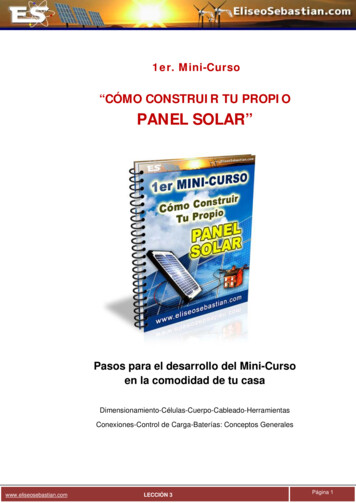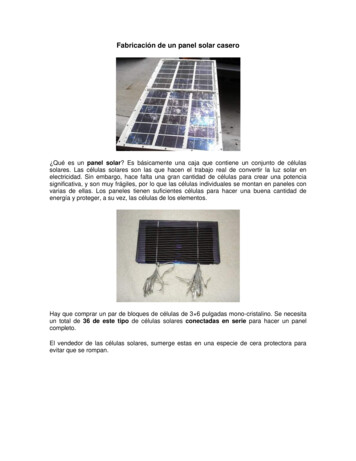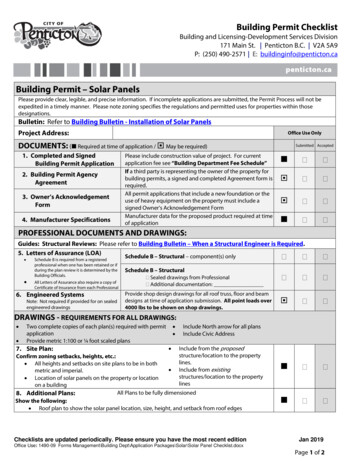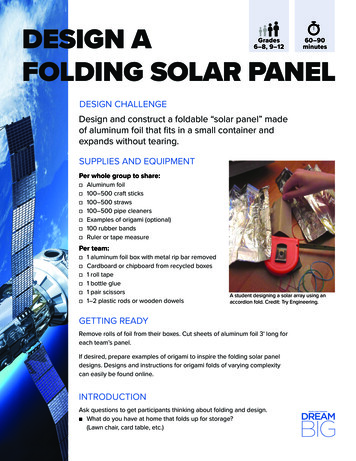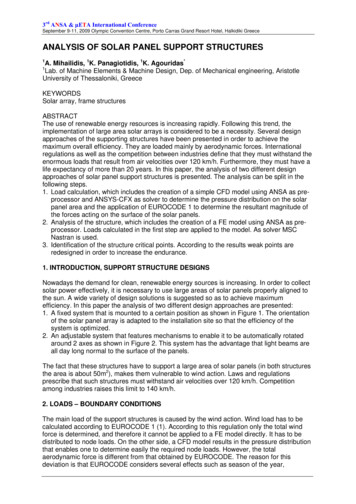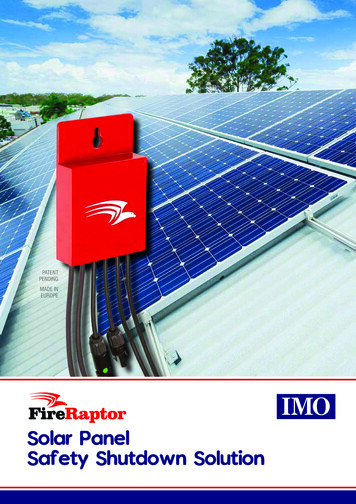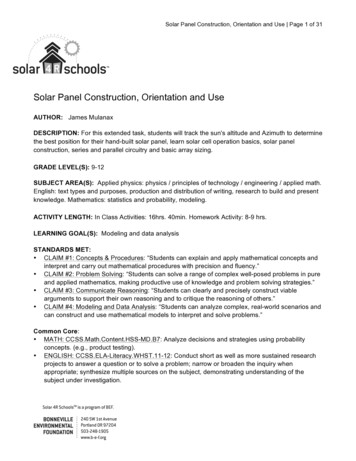
Transcription
Solar Panel Construction, Orientation and Use Page 1 of 31Solar Panel Construction, Orientation and UseAUTHOR: James MulanaxDESCRIPTION: For this extended task, students will track the sun's altitude and Azimuth to determinethe best position for their hand-built solar panel, learn solar cell operation basics, solar panelconstruction, series and parallel circuitry and basic array sizing.GRADE LEVEL(S): 9-12SUBJECT AREA(S): Applied physics: physics / principles of technology / engineering / applied math.English: text types and purposes, production and distribution of writing, research to build and presentknowledge. Mathematics: statistics and probability, modeling.ACTIVITY LENGTH: In Class Activities: 16hrs. 40min. Homework Activity: 8-9 hrs.LEARNING GOAL(S): Modeling and data analysisSTANDARDS MET: CLAIM #1: Concepts & Procedures: “Students can explain and apply mathematical concepts andinterpret and carry out mathematical procedures with precision and fluency.” CLAIM #2: Problem Solving: “Students can solve a range of complex well-posed problems in pureand applied mathematics, making productive use of knowledge and problem solving strategies.” CLAIM #3: Communicate Reasoning: “Students can clearly and precisely construct viablearguments to support their own reasoning and to critique the reasoning of others.” CLAIM #4: Modeling and Data Analysis: “Students can analyze complex, real-world scenarios andcan construct and use mathematical models to interpret and solve problems.”Common Core: MATH: CCSS.Math.Content.HSS-MD.B7: Analyze decisions and strategies using probabilityconcepts. (e.g., product testing). ENGLISH: CCSS.ELA-Literacy.WHST.11-12: Conduct short as well as more sustained researchprojects to answer a question or to solve a problem; narrow or broaden the inquiry whenappropriate; synthesize multiple sources on the subject, demonstrating understanding of thesubject under investigation.
Solar Panel Construction, Orientation and Use Page 2 of 31Student Background:Stimulus/Source:Students will have access to panels and brochures completed by other students from previoussemesters. Their work may or may not be correct. The purpose of the available work is to provide a“visual” of what is to be expected of the student by the teacher.Educator Background:Scaffolding Techniques: Frequently clarify lecture and notes. List objectives for the day in a place where students can see them. Begin each class with a review and short vocabulary. Demonstrate proper tool use to prevent damage to equipment and self. Have on-hand completed sub-assemblies and working PV Module.During this assignment, it will be considered reasonable to help the students to set up the testingequipment, to allow some students to work together, to praise where credit is due, and to correctstudent usage of measuring tools and other tools related to the solar panel construction and testing.However, it is the students’ responsibility to collect data, arrange data, and compile the data into apresentable brochure. The point of this experiment is to use the collected data and experiencesgathered from their solar technology exercise to develop a logical and presentable persuasivebrochure about their solar panel design. The brochure should mimic their proficiency on the subject.Science Kit Materials List: Multimeter (1 per 2 students)Single Solar Car Kit (1 per class)Other Materials List: “Handouts for Mulanax Solar Panel Project”PV Cells (4 per student) 125mm x 125mm quasi-square crystallineCalibrated Solar Cell (1 unit per 4 students)Tab Ribbon & Bus Ribbon (one (1) roll will serve 25 students) 3/16" wide and 3/32" wide ribboneach in a 50 foot rollAluminum Bar-Stock (1/4" x 1" x 6' per student)May substitute 1/4" x 1" x 6' Fir wood stock for cost reductionAluminum Sheet (1 sheet will serve 36 students), 1/8" x 4' x 8' sheetMay substitute 1/8" x 4' x 8' door-skin or fiberboard for cost reductionPolycarbonate (1 sheet will serve 36 students), 1/8" x 4' x 8' sheet
Solar Panel Construction, Orientation and Use Page 3 of 31 Nylon or Plastic Screen (1 roll will serve 36 students), 4' x 8' rollLayout Board (1 sheet will serve 36 students), 1/8" x 4' x 8' door-skin or fiberboardBolts (16 nuts and bolts per student), 1/4" x 1/2" National Coarse grade five machine screws/boltsSolder (1 roll per soldering iron/gun station), One pound electronic 60/40 x 0.050" solder rollFlux Pen (1 pen per soldering station)Clear Silicone (Two (2) tubes per 25 students), Standard 2" x 8.5" caulking gun tubeJunction Box (1 per student)2-Position Dual Row Barrier Strip (1 per student)Electrical Tape (1 roll per 6 students)Digital Soldering Gun w/chisel tip (1 per 4 students)May substitute lower quality soldering gun for cost reduction, but students will have a difficult timecontrolling heat.Caulking Gun (2 per 25 students)Paint Brush (1 per student). Low grade 2" disposable bristle brushBook: Build Your Own Solar Panel: Generate Electricity from the Sun by Phillip Hurley. ISBN 9780-9837847-1-5Book: Teaching Solar by Rahus InstituteHacksaw (1 per 6 students)Exacto Knife (1 per 6 students)Screwdriver (1 per 6 students)Pencil (1 per student)Ruler (1 per 2 students)Drill (1 per 12 students)Electrical Wire (1 roll per 4 students), One (1) 25' roll of 12-gauge automotive, multiple strandinsulated copper wireClear Semi-Hemisphere and Compass Card (1 per student)Vocabulary: AC (alternating current): Typical household electricity; electrical current that flows alternately intwo directions. The positive and negative switch back and forth 60 times per second in the UnitedStates. This rate (hertz) varies from country to country.AM (air mass): The relative thickness of air that solar radiation must pass through to reach theearth's surface.Array: A complete photovoltaic power-generating system.Azimuth angle: The horizontal angle between where the sun is relative to due south (in thenorthern hemisphere).Battery: A collection of electrochemical cells that are contained in the same case in such a way toproduce a desired voltage.Battery bank: A group of batteries connected together in such a way to produce a desired voltage.Current-voltage (I-V) characteristic: The basic electrical output of a PV device.DC (direct current): Electrical current that flows in one direction only.Doping: The process of adding small amounts of impurities to semiconductors to alter theirelectrical properties.
Solar Panel Construction, Orientation and Use Page 4 of 31 Load: A piece of equipment that consumes electricity.Maximum power current (Imp): The operating current on an I-V curve where the power is atmaximum.Maximum power point (Pmp): The operating point on an I-V curve where the product of current andvoltage is at maximum.Maximum power voltage (Vmp): The operating voltage on an I-V curve where the power output is atmaximum.Module: A PV device consisting of a number of individual cells connected electrically, laminated,and packaged into a frame.N-type semiconductor: A semiconductor that has free electrons (negative).Open-circuit voltage (VOC): The maximum voltage on an I-V curve and is the operating point for aPV device under infinite load or open-circuit condition, and no current output.Photon: A unit of electromagnetic radiation.Photovoltaic cell: A semiconductor device that converts solar radiation into direct currentelectricity.Photovoltaic effect: The movement of electrons within a material when it absorbs photons withenergy above a certain level.Photovoltaics: A solar energy technology that uses unique properties of semiconductors to directlyconvert solar radiation into electricity.Photovoltaic (PV) system: An electrical system consisting of a PV module array and otherelectrical components needed to convert solar energy into electricity usable by loads.P-N junction: The boundary of adjacent layers of p-type and n-type semiconductor materials incontact with one another.P-type semiconductor: A semiconductor material that has electron voids (positive).Radiation: Energy that emanates from a source in the form of waves or particles.Reference (calibrated) cell: An encapsulated PV cell that outputs a known amount of electricalcurrent per unit of solar irradiance.Semiconductor: A material that can exhibit properties of both an insulator and a conductor.Lesson Details:Part 1 (20 Minutes): The Reason for the Seasons(Pg. 5) (Teaching Solar / Rahus Institute)Passive Solar (does not change) the collector surface angle remains fixed.Most solar energy is received when the cell array faces directly towards the sun.Proper solar panel orientation for maximizing input requires an understanding of how the suntracks across the sky in your particular area both daily and yearly (see Fig. pg. 5, Teaching Solar).
Solar Panel Construction, Orientation and Use Page 5 of 31Seasonal differences and the maximum height and minimum height of the sun are caused by theearth's position as it orbits around the sun. The tilted axis of the earth is fixed (see Fig. pg. 5,Teaching Solar).Part 2 (20 minutes): How the Sun’s Position Affects Available SolarEnergy/Brilliance(Pg. 8 Teaching Solar) Using a good quality flashlight, demonstrate how the sun casts its light on the ground whendirectly overhead and at an oblique angle.An overhead will produce a circular pattern that is bright (concentration of light per area is at itsgreatest).An oblique angle (45 degrees) will produce a dimmer light but cast light over a larger surface(concentration of light is minimized per area). The power density of the light is shared over a largerarea. (The intensity of the flashlight can also be demonstrated by shining the light directly in aperson's eyes or obliquely.)Use this demonstration to show how the earth's tilted axis can affect the "quality" of the light andthe angle the sun shines on the earth (summer versus winter) in relation to where we are on theplanet.Use Figs. on pg. 8.
Solar Panel Construction, Orientation and Use Page 6 of 31NNSUNM o n roe , OR .obl iquesun castAREA OF LIGHTCONCENTRATIONAREA OF LIGHTCONCENTRATION(o v erhea d su n c ast )M o n roe , OR .SWINTERSSUMMERPart 3 (20 minutes): Finding True North and South Without a Compass(Pg. 7 Teaching Solar / Rahus)Demonstrate how to find "true north" using the method below. Assign students homework to create acompass on the ground of their yard or driveway to be used when they proceed with their sun trackingexercise. Use shadow tracings. Use a paper cup and supported/weighted skewer. Show students how tocreate a simple system by taping small rocks to a wooden skewer and pushing the skewer throughthe bottom of the cup from the inside. Place the cup open-mouth down with the skewer in the airand demonstrate its use, as per instructions below.Trace shadow at a given time and label "W" for west.Trace shadow again 1-2 hours later and label "E" for east.Draw a line from the top of both shadows.Stand on the line with "E" to your right – you are facing "true north.”
Solar Panel Construction, Orientation and Use Page 7 of 31Part 4 (80 minutes): Measuring the Sun’s Position (Altitude & Azimuth)(Pg. 8 Teaching Solar / Rahus)Altitude: Sun's height above the horizon (Fig. pg. 9 Teaching Solar).Azimuth: Sun's direction on a compass as measured from due south (Fig. pg. 9 Teaching Solar).ALTITUDE TEACHER: Construct paper altitude finder located on page 86 of Teaching Solar.Teacher then demonstrates proper and safe use of the altitude finder (do not look at the sun!) asexplained by Rahus Institute.Be sure to remind students that zero degrees is at/on the horizon.STUDENTS: Students then construct altitude finder, go outside to a designated spot and measurethe sun's altitude at the present time.AZIMUTH TEACHER: Reiterate finding the sun's Altitude and then demonstrate finding the sun's Azimuthusing a clear hemisphere as per Rahus instructions (Fig. pg. 9 Teaching Solar).
Solar Panel Construction, Orientation and Use Page 8 of 31 Start this exercise by drawing north, south, east, and west on a piece of paper large enough toplace under the clear semi-hemisphere. The direction of the rough compass card can beapproximate for demonstration purposes.Continue this exercise by showing how to pinpoint the sun's location on the plastic semihemisphere. Draw its location with a small point using a non-permanent marker.Then, draw a line straight down from the sun's location on the clear semi-hemisphere to thehorizon on the compass card. From that point to true north (angle in degrees) is the sun's Azimuth(Fig. pg. 9 Teaching Solar).STUDENTS: Students will go outside to practice measuring the sun's Azimuth with their clearsemi-hemispheres and ready-made compass cards. The teacher needs to observe, correct andpraise as the students will later take their units home and track the sun over a given number ofhours.Part 5 (20 minutes): Tracking the Sun(Pg. 11 Teaching Solar / Rahus)TEACHER: NOTES TO SHARE: Bulk of solar energy is delivered between 9 am and 3 pm. Sun's track during the summer months is higher due to earth's tilted axis and orbit around the sun.(Highest on June 21st). Sun's track during the winter months is lower due to earth's titled axis and orbit around the sun.(Lowest on December 21st). Solar window occurs vertically between 9 am and 3 pm and horizontally between December 21stand June 21st. Demonstrate development of solar window on clear hemisphere (Fig. pg. 15 Teaching Solar).Part 6 (20 minutes): ReviewUsing a clear hemisphere, review the sun's altitude, Azimuth, tracking and the solar window that iscreated based upon the notes shared above.Part 7 (8-9 hours): Charting the Sun’s Path(Pg. 15 Teaching Solar / Rahus) STUDENTS: Homework, as per handoutStudents will set up their north, west, south, and east compass grid on their driveway at home orin their yard.
Solar Panel Construction, Orientation and Use Page 9
brochure about their solar panel design. The brochure should mimic their proficiency on the subject. Science Kit Materials List: Multimeter (1 per 2 students) Single Solar Car Kit (1 per class) Other Materials List: “Handouts for Mulanax Solar Panel Project” PV Cells (4 per student) 125mm x 125mm quasi-square crystallineFile Size: 1MBPage Count: 31

